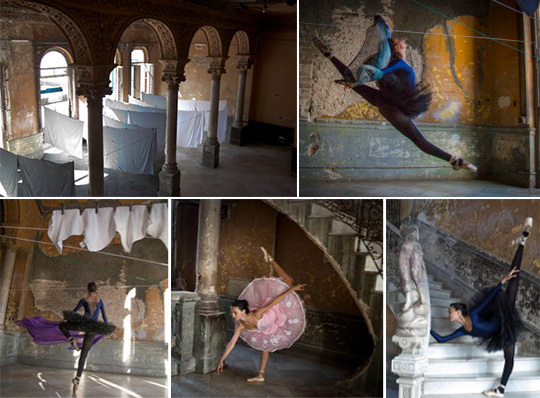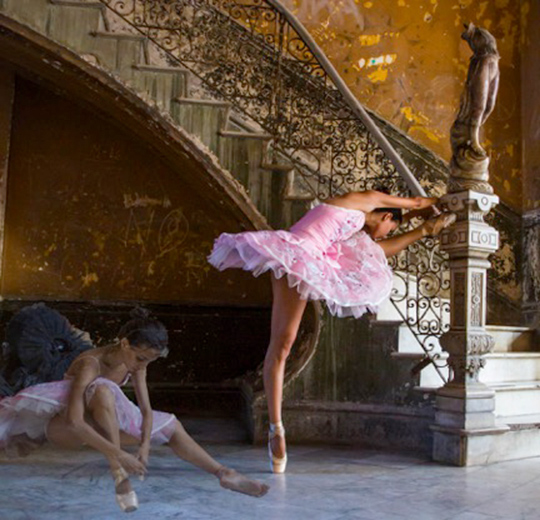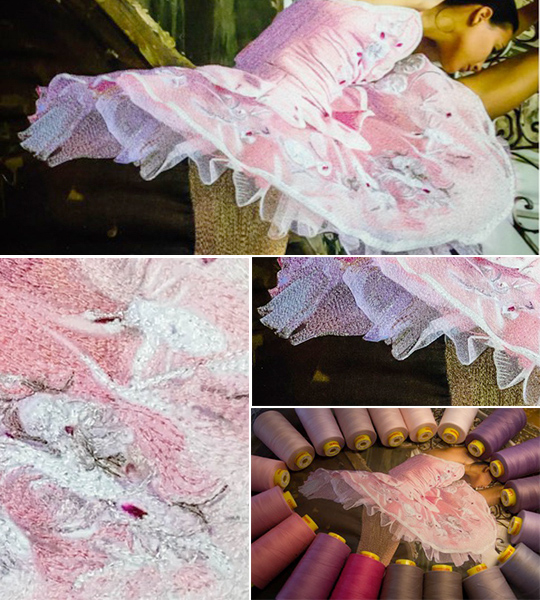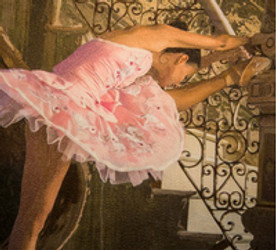Cuban Ballerina from Thread Stories
Posted by Jennifer Day on Sep 30th 2015
Today we have another special guest on the blog for National Sewing Month: Jennifer Day, author of Thread Stories! In this post she takes us on a photographic journey through the process of creating her quilt Cuban Ballerina, pictured in the gallery section of her book. I'll let her take it from here!
As I created the quilt Cuban Ballerina, I also created a pictorial story of its creation. Each photograph documents the journey through the design process of this art. This is an amazing journey.
This art quilt begins with a photograph I took in Havana, Cuba. Several dancers with the world-renowned Cuban National Ballet met to dance in an old building downtown in Old Havana. In the 1950s, the building was once a grand structure, complete with marble floors, stairs, gilt ironwork, and statuary. Elegant arches and arched windows grace the hall where the dancers gathered. All are in disrepair today. The marble is cracked. The ironwork is rusted. The statue that sits at the base of the grand staircase is missing her head. The walls are covered in graffiti and there is laundry from the restaurant on the third floor hanging in the grand hall. Once a fabulous center of romance and nightlife, now this fabulous building is in disrepair. This is the state of Havana.
The dancers of the Cuban National Ballet begin their studies at the age of five. After completing the training, a dancer earns approximately $30 a month, which is comparable to the salaries of doctors and skilled workers. They represent the heart of culture and refinement in Cuba.
I spent several fascinating hours with the young ballerinas. I moved with them, photographing them as they danced in this grand hall.
These are some of the photographs that I took:

I chose this photograph below to use for my art quilt. I love her toe pointing on the stair. I took some creative license and added a translucent image of her putting on her point shoes to the photograph. I wanted to show her preparations for dance as well as her performance.

The following is a step-by-step photographic journey that shows how this quilt evolved into a piece of art.
The first step required on any quilt using the thread stories technique is auditioning threads. This means selecting threads that match the coloration of the photograph. I do this by laying the threads over the areas to be stitched. Many threads are analyzed before the correct thread is chosen. I have already stitched two colors of thread on her leg and will add two more that catch the light reflection.

Her finished leg includes eight thread changes. From the shadow on her thigh to the lightest color on her shinbone, the colors gradually become lighter and are blended almost seamlessly.
I always choose a section of a quilt to start on and then work my way out from that point. I wanted to finish the ballerina first and chose to begin on her leg. The next area to be stitched is her dress.
Her dress is a fantasy of pink satin, jewels, and tulle. I stitched the dress in sixteen different colors of thread. This took hours; I changed threads constantly as I moved from her leg towards her bodice.

I chose to stitch fairly lightly, letting the color of the photograph come to the fore in several sections. In the photograph above, you can see the pink area to the right of the central flower has only a few stitches of a darker pink thread. This gives movement to the area, but still allows the lighter pink to be seen. This also “tricks” the eye into seeing a third color when the viewer stands back. I could have covered this portion of the quilt entirely in thread, but by stitching in this manner, I created a three-dimensionality that adds to the finished product.
I also left a lighter pink area above the flower without stitching. I could have added another thread color here, but this allows the fabric of her dress to become almost translucent.
As you begin the sewing process, it is important to analyze clothing to determine if you want the fabric of the clothing to be an important part of the story–covered completely in thread–or if it is a supporting theme. In this case, the dress is almost as important as her movement as she dances, so I left wisps of the cloth without thread.
The tulle under her skirt is naturally semi-transparent. I used seventeen different colors of thread in this small space. Yes, this drove me a bit crazy as I changed threads at least once every five to seven minutes, blending the tones of color in her skirt. The direction of the stitching creates a flow to the fabric that simulates movement as she dances. The white horizontal lines near the right of the photograph emulate the texture of the tulle.
Above you can also see the colors that I used in the ballerina's dress. These nineteen colors of thread have very minute gradations in the pinks and purples. If you were to try to create her dress using threads purchased from the quilt shop, you would quickly become frustrated. That is why I use the Gutermann Mara line of threads. These threads were created for the garment industry. You can purchase these online from a notions company by the name of Wawak. I use the Gutermann Mara 100 40-weight thread or Gutermann Mara 70 30-weight thread. These threads are very inexpensive and are available in 1,000-meter cones. I have all 692 colors in my thread “paint box.”
Now that the dress is complete, it is time to work on her arms and head. The technique of covering her arms and face with thread begins with stitching the dark threads first. I began with the shadows on her upper arm. I completed her upper arm first and then moved to her face, her hair, her second arm, and her leg. I did this in this order so as not to create “pockets” of unstitched fabric that can become a wrinkled area when it is time to cover them in thread. Wrinkles can become a problem if they are not heavily stitched. They will attract the viewer's eye unnecessarily and detract from the overall art.

I finished the quilt, then chose to add more threads to her face, the arm behind her head, and the point of her shoe. It is impossible to finish all of the areas of a quilt as they are stitched in progression. It is important to stand back and view the quilt in its “finished” state to determine the areas that need additional attention. I smoothed the skin tones on her arm, adding a bit more color to give her skin vibrance. Additional threads added to her jawline soften her skin and create a glow to her face. I also added a shadow at the point of her slipper to give definition to this area.
The balance of the quilt was finished as I thread-painted the stair and wall behind the ballerina.

Thank you for following this in-depth exploration of my book Thread Stories. Thread Stories delves deeper into the thread-painting process. There are more tricks to be learned about how to create portraits of both people and pets. The book is available on ctpub.com now.
Enjoy!
If you enjoyed Jennifer's post and would like to learn more about her technique of thread-painting, you can enter our giveaway to win a free copy of her book (hard copy for US winner, ebook for international winner) here: a Rafflecopter giveaway. We will pull and announce a winner one week from today.
Congratulations to Diana W.G., winner of this giveaway! And thank you so much to everyone else who entered.







